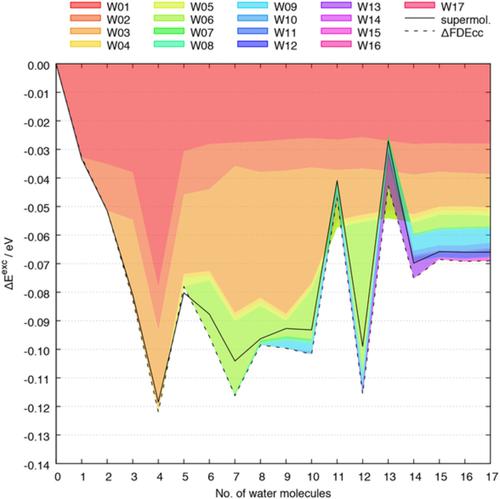当前位置:
X-MOL 学术
›
Int. J. Quantum Chem.
›
论文详情
Our official English website, www.x-mol.net, welcomes your
feedback! (Note: you will need to create a separate account there.)
Analysis of environment response effects on excitation energies within subsystem‐based time‐dependent density‐functional theory
International Journal of Quantum Chemistry ( IF 2.3 ) Pub Date : 2020-04-01 , DOI: 10.1002/qua.26213 Linus Scholz 1 , Johannes Tölle 1 , Johannes Neugebauer 1
International Journal of Quantum Chemistry ( IF 2.3 ) Pub Date : 2020-04-01 , DOI: 10.1002/qua.26213 Linus Scholz 1 , Johannes Tölle 1 , Johannes Neugebauer 1
Affiliation

|
We analyze the ability of subsystem time‐dependent density‐functional theory (sTDDFT) to describe environmental response effects. To this end, we utilize the recently proposed “exact” version of sTDDFT relying on projection‐based embedding (PbE), which so far was applied only for the special case of two subsystems. We confirm that PbE‐sTDDFT in combination with supersystem bases yields results equivalent to those of supermolecular TDDFT calculations for systems solvated by many solvent molecules, using the previously studied system of methylene‐cyclopropene⋯(H2O)17 as an example. By means of this exact reference embedding framework, we are able to disentangle solvent effects introduced in terms of the embedding potential from those caused by solvent response couplings, both for the PbE variant and for sTDDFT with approximate non‐additive kinetic energy functionals. Furthermore, we show that the use of a monomer basis introduces significant errors for the environmental response contribution. Employing a virtual‐orbital localization strategy on top of PbE‐sTDDFT, we can also directly assess the impact of inter‐subsystem charge‐transfer excitations on the entire solvent effect, which turn out to play a significant role for the environmental response. Finally, we analyze the response effects introduced by the individual solvent molecules and their interdependence, and show that a simple, pair‐wise additive correction for solvent response yields excellent results in the present example.
中文翻译:

基于子系统的基于时间的密度泛函理论中的环境响应对激发能的影响分析
我们分析了子系统随时间变化的密度泛函理论(sTDDFT)来描述环境响应效应的能力。为此,我们利用了最近提出的sTDDFT的“精确”版本,该版本依赖于基于投影的嵌入(PbE),到目前为止,该版本仅适用于两个子系统的特殊情况。我们确认,PBE-sTDDFT与超系统基地产量组合产生等同于超分子TDDFT计算用于通过许多溶剂分子溶剂化的系统中,使用的亚甲基环丙烯⋯(H先前研究的系统2 O)17举个例子。通过这种精确的参考嵌入框架,我们能够将嵌入效应方面的溶剂效应与溶剂响应偶合引起的那些效应区分开来,无论是PbE变体还是具有近似非加成动能功能的sTDDFT。此外,我们表明使用单体基础会为环境响应贡献带来重大错误。利用PbE-sTDDFT之上的虚拟轨道定位策略,我们还可以直接评估子系统间电荷转移激发对整个溶剂效应的影响,这对于环境响应起着重要作用。最后,我们分析了各个溶剂分子及其相互依赖性带来的响应效应,并证明了简单,
更新日期:2020-04-01
中文翻译:

基于子系统的基于时间的密度泛函理论中的环境响应对激发能的影响分析
我们分析了子系统随时间变化的密度泛函理论(sTDDFT)来描述环境响应效应的能力。为此,我们利用了最近提出的sTDDFT的“精确”版本,该版本依赖于基于投影的嵌入(PbE),到目前为止,该版本仅适用于两个子系统的特殊情况。我们确认,PBE-sTDDFT与超系统基地产量组合产生等同于超分子TDDFT计算用于通过许多溶剂分子溶剂化的系统中,使用的亚甲基环丙烯⋯(H先前研究的系统2 O)17举个例子。通过这种精确的参考嵌入框架,我们能够将嵌入效应方面的溶剂效应与溶剂响应偶合引起的那些效应区分开来,无论是PbE变体还是具有近似非加成动能功能的sTDDFT。此外,我们表明使用单体基础会为环境响应贡献带来重大错误。利用PbE-sTDDFT之上的虚拟轨道定位策略,我们还可以直接评估子系统间电荷转移激发对整个溶剂效应的影响,这对于环境响应起着重要作用。最后,我们分析了各个溶剂分子及其相互依赖性带来的响应效应,并证明了简单,











































 京公网安备 11010802027423号
京公网安备 11010802027423号